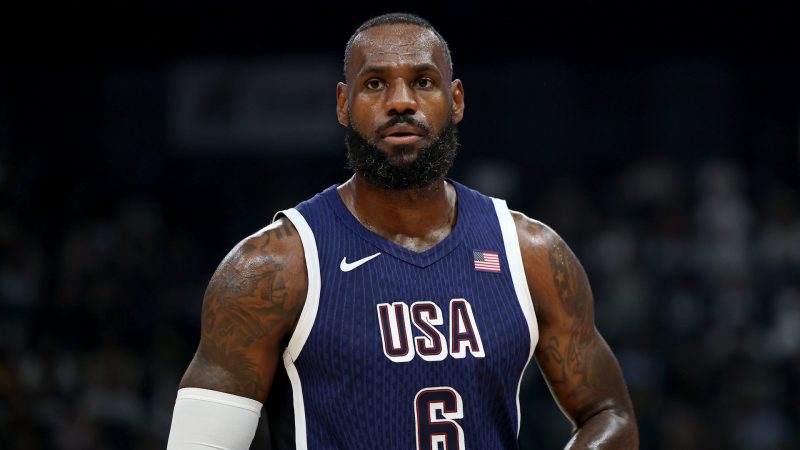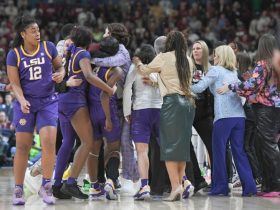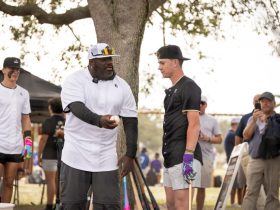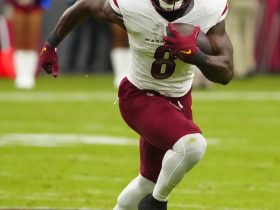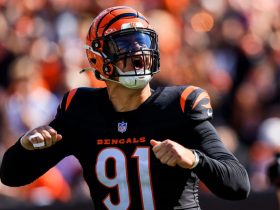VILLENEUVE-D’ASCQ, France — Limit LeBron James. Limit Steph Curry. Limit Kevin Durant. And Anthony Davis and Joel Embiid and Anthony Edwards and Devin Booker and Jayson Tatum. And on and on and on.
When put that way, the idea of beating the U.S. men’s 5×5 basketball team at the 2024 Paris Olympics seems daunting if not impossible.
Beating the U.S. team loaded with All-Stars won’t be easy, but it’s doable. South Sudan and Germany proved that in exhibition games in the past week – South Sudan lost 101-100 (with a chance to win on the game’s final shot) and Germany fell 92-88.
Both teams provided a blueprint for upsetting the heavy gold-medal favorite. Serbia will be first up when the U.S. opens its group play Sunday.
How a team can beat the U.S. at the 2024 Paris Games:
Meet Team USA: See which athletes made the U.S. Olympic team and where they are from
3-point shooting is a major factor
Germany and South Sudan made enough 3-pointers to keep it close. The U.S. will put up points with its elite scorers even if it’s not shooting great, so an opponent will need to keep up. Hitting 3s is one way to do that.
Germany shot just 44.4% from the field and just 28.9% on 3-pointers. However, it made seven more 3s than the U.S. South Sudan shot 42.4% on 3s, making 14 – also seven more than the U.S. In five exhibition games, the U.S. was even in 3s made against Canada, Serbia, Australia, South Sudan and Germany at 48 apiece.
Getting hot from 3 will give a medal contender an avenue to victory against the U.S.
Rely on continuity the U.S. lacks
The U.S. assembled 12 players who have not played together as a full squad. Sure, Kevin Durant and Steph Curry were teammates with Golden State, and Durant and Devin Booker are teammates with Phoenix, and Jayson Tatum, Jrue Holiday and Derrick White are teammates with Boston.
Teams like Germany, Australia, Serbia and France have important players who have played in multiple international competitions together such as last summer’s FIBA World Cup which Germany won. Several players from Germany’s gold-medal team, including Dennis Schroder, Franz Wagner, Mo Wagner, Daniel Theis, Andreas Obst, Johannes Voigtmann and Isaac Bonga, are back for the Olympics.
Australia has a roster of players who have played together (Joe Ingles, Matthew Dellavedova, Patty Mills, Dante Exum, Josh Giddey, Josh Green) and are in the NBA. Canada beat the U.S. for bronze at the 2023 World Cup, and Shai Gilgeous-Alexander, RJ Barrett, Dillon Brooks, Lu Dort, Kelly Olynyk, Dwight Powell and Nickeil Alexander-Walker are in Paris from that team.
The U.S. relies on a team coming together quickly and incredible talent to compensate for a lack of chemistry. It works most of the time − the U.S. is going for its fifth consecutive Olympic gold. But as other national teams improve the quality of their rosters with more NBA players, the talent gap isn’t as wide and continuity has an impact. Just two players (Edwards and Tyrese Haliburton) played on the U.S. 2023 FIBA World Cup team.
‘If you look on paper, obviously they’re the most talented team, it’s not a secret to anybody,” Australia’s Giddey said. “The difference is these guys (on the U.S.), they’ve never played together, whereas a lot of these other countries have a core and have been together for years. I think those type of things really do (have) an effect.”
Force U.S. turnovers
In the exhibition games, the U.S. had more turnovers than its opponents (72-62) and posted a mediocre assist-to-turnover ratio. Sometimes, it was sloppy play. Sometimes, it was that lack of continuity with one U.S. player passing to where he thinks a teammate should be but isn’t. Or trying to make a fancy play when the basic will do.
If an opponent can limit its turnovers and get extra scoring chances from U.S. turnovers, that gives a team a chance to keep pace with U.S. scoring. The fewer turnovers by a U.S. opponent also means fewer transition opportunities for the U.S., which thrives in the open court on fastbreak chances.
Expose U.S. rotations
U.S. coach Steve Kerr has 11 All-Stars plus All-Defense selection Derrick White. In pre-Olympic contests, Kerr has tried to play the entire roster as much as possible, including wholesale, five in, five out substitutions. But in highly competitive events, including the NBA playoffs, rotations tighten and coaches rely on eight players, maybe nine tops, so the best players play a majority of the game.
Yes, it’s a luxury that Kerr can replace James with Tatum or Embiid with Davis or Curry with Edwards and right on down the bench.
Trying to figure out the right five-man combinations in short time isn’t easy. There’s an art and science to it, and there may be situations when Kerr has to sit an All-NBA player for long stretches and/or limit minutes. Is he willing to do that? Can he do that without hurting egos?
Maximize FIBA rules against the U.S.
In FIBA, it’s a 40-minute game compared to 48 in the NBA. That means fewer possessions per game and less time to come back from a large deficit. Defensive three seconds is allowed so teams can pack the paint and cut off driving lanes to the rim, especially with zone defenses.
It can be a more physical game, too, with referees allowing significant contact and not making the game a parade to the free throw line.
“We have seen that when the United States struggles in recent years, whether they win in a close game or lose like we did in the World Cup, in part it’s because I don’t think they understand the difference in the rules in terms of how fast the game goes,” international basketball expert Fran Fraschilla said.
Other factors
Great point guard play is important, and while the U.S. has playmakers, it doesn’t have a dedicated point guard. Can teams take advantage there?
Make someone other than James beat you. He was unstoppable against South Sudan and Germany with the game on the line. That task is easier said than done, as are all the other components.
It’s going to take a sub-par game by the U.S. and near-perfect game by an opponent. But in a one-game scenario – like the NCAA tournament and not a best-of-7 – it’s possible.
Follow NBA reporter Jeff Zillgitt on social media @JeffZillgitt
The USA TODAY app gets you to the heart of the news — fast. Download for award-winning coverage, crosswords, audio storytelling, the eNewspaper and more.

